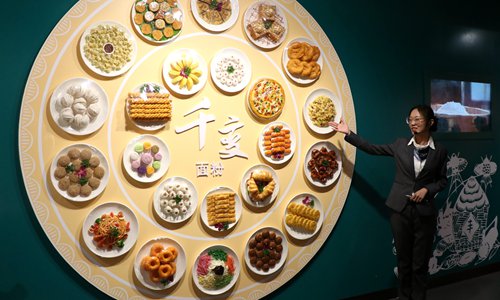HOME >> ARTS
New museum explores the role of grain in ancient China
By Bi Mengying Source:Global Times Published: 2019/10/21 18:48:39

A guide leads a tour at the Capital Grain Museum in Beijing on October 16. Photo: IC
Tiantan Instant Noodles produced by the state-run Beijing Number Two Mill was one of the most popular household brands among families in Beijing back in the 1980s.
"At that time, instant noodles were something rare. But Tiantan came in seafood, spicy, chicken broth, and mushroom flavors… Even employees at the mill like us had to ask people for favors to buy them," said Dou Liang, who first began working at the Beijing Number Two Mill in 1987. Located near Yongding Gate, only four kilometers away from Tiananmen Square, the Beijing Number Two Mill was closest to the center of the city among the 12 mills that existed in the capital back during the 1990s.
According to media reports, the instant noodles were discontinued in March, 1999 due to rising completion from other brands.
The mill itself continued operating for the next fifteen years, but finally became nothing but a memory for workers like Dou as it was shut down in 2014.
For those that wish to get a peek into this part of the capital's history, the original location of the mill has been transformed into a creative industry park named Grand Mill, while a portion of buildings have been converted into a museum. On Wednesday - World Food Day - the Capital Museum of Grain officially opened to the public, with the aim of bringing back the memories of yesteryear.
Upon entering the park, visitors are greeted by a sign that reads "this was the earliest mill in Beijing."
"We chose this location because of its historical significance… It is one of the 10 food security education centers in Beijing. Currently, there are two floors open to visitors, who can make appointments online for a free visit," introduced Wang Yang, a manager at Grand Mill.
The museum is divided into several sections based on different themes, starting with the origin of grain in ancient China. Through texts, photos and samples of various grains, such as rice, proso millet, wheat and barley displayed in chronological order, the museum showcases how they were first cultivated in China during the Neolithic, and the agricultural development that followed over the centuries. Replicas of various ancient tools used for farming and processing grain are also on display and for most of them, visitors are encouraged to try them out to see how they work.
The timeline hops to the Ming (1368-1644) and Qing dynasties (1644-1911). During this time, many time-honored grain shops, restaurants and taverns sprang into existence, many of which, including Heshunju Tavern and Daheheng Grain Shop, have been recreated at the museum.
As to the section focusing on more modern times, there are more than 500 items and 400 photos. According to Wang, many were actually donated by Beijing residents, such as a variety of food stamps and work identification papers for the food administration system used prior to China's reform and opening up. Aside from pictures of commonly consumed dishes in 1960s' Beijing, there are also recreations of state-owned grain shops.
A visitor in her 50s was showing great interest in one grain shop.
"It is exactly like the grain shops I used to visit when I was a child. The clerk poured the flour down a funnel, and I would go home with a full bag," she said.
Newspaper headline: Milling about history
Posted in: ART,CULTURE & LEISURE